#organic fertilizer for potted plants
Text
5 Type of Best Organic Fertilizers That You Must Have for Your Home Garden
Organic fertilizers are a substance composed of animal or vegetable matter used alone or in combination with one or more non synthetically derived elements or compounds.
These fertilizers are naturally produced and are materials that can be added to soil or plants, in order to provide nutrients and sustain growth.
Typical organic fertilizers include all animal waste including meat processing…
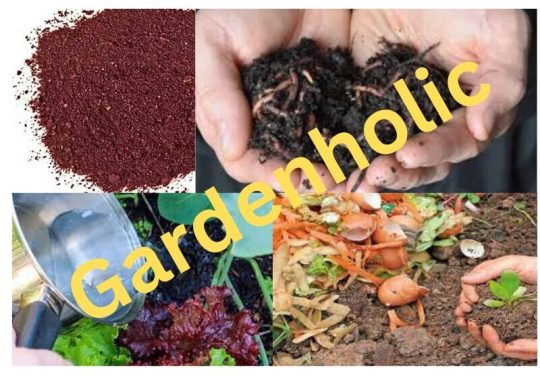
View On WordPress
#best fertilizer for organic gardening#best organic fertilizer brands#certified organic fertilizer list#complete organic fertilizer recipe#different types of organic fertilizers#fertilizers used in organic farming#Gardening tips#homemade organic fertilizer for vegetables#homemade organic fertilizer recipe#how do chemical pesticides affect plants#how do organic farmers fertilize#how to use organic pesticides around children and pets#make your own organic fertilizer#natural fertilizers#organic farming fertilizer types#organic fertilizer#organic fertilizer for flowering plants#organic fertilizer for potted plants#organic fertilizers#organic gardening#organic nitrogen fertilizer homemade#resources for gardeners#top 10 best organic fertilizers
0 notes
Text
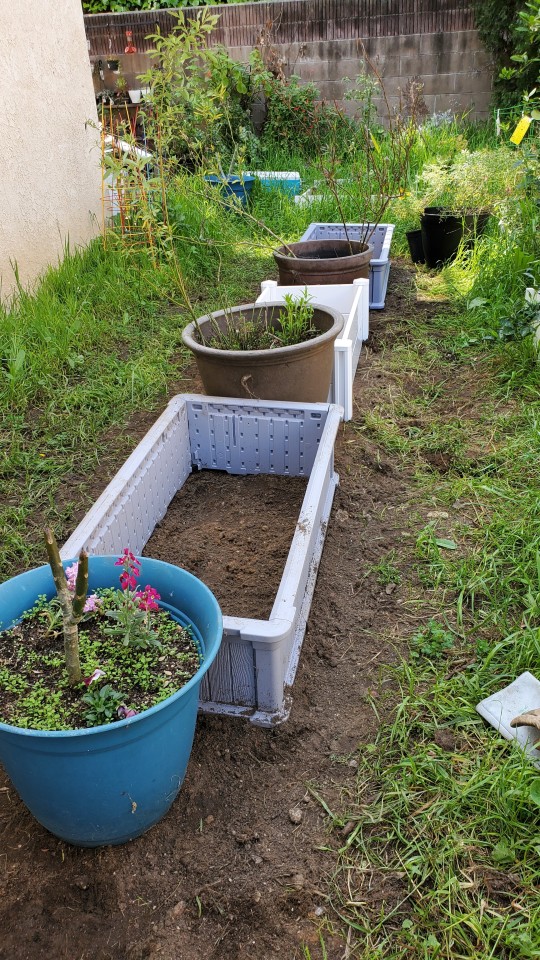
Narrow raised beds are set up. One is now filled. I came to the realization that I can't fit 15 bags of potting soil in the trunk of a mid sized sedan, so we're breaking it down into a couple of trips once a week. I got 4 big bags for the beds today and 3 cactus/palm mix so I can plant two the new bulbs I got and repot some overgrown succulents. I managed to piss of several spiders and one bee in the process (also one of the big reasons I like going out to work in the yard at dawn and not in the middle of the day). Now to wait for the tomato seedlings to get big enough to transplant and we're good to go.
#adventures in gardening#i already used 4 and half of the 6 bags of soil i got#need to add the fertilizer later and mix it in thoroughly#the new beds will get a lot of sun once summer hits#just waiting on one more to arrive so i can finish moving the pots and finish in the yard#then it's patio plant organization time#again
2 notes
·
View notes
Text
Best potting soil

Introducing our Best potting soil, meticulously crafted to raise your gardening enjoyment to new heights of achievement. Our precise combination is enriched with a harmonious mixture of organic ingredients, including Desi cow manure, cocopeat, organic soil, goat manure, vermicompost, and a particularly curated vegetable blend, putting a new standard for plant nourishment and energy.
At the heart of our potting soil lies the nutrient-rich Desi cow manure, respected for its capacity to enhance soil fertility and promote strong plant increase. Combined with cocopeat, a sustainable alternative to standard peat moss, our soil combo gives exceptional water retention and aeration, creating the most fulfilling surroundings for wholesome root development.
Organic soil sourced from top rate sources ensures the purity and integrity of our combo, whilst goat manure provides an extra boost of vitamins to support full of life plant growth. Vermicompost, teeming with beneficial microorganisms, enriches the soil microbiome, promoting nutrient cycling and universal soil fitness.
To in addition enhance plant vitamins, we have included a carefully balanced vegetable mix, packed with vital nutrients, minerals, and hint factors. This synergistic combo of organic ingredients creates the best potting soil that nourishes your plants from the roots up, ensuring colourful increase and abundant harvests.
Experience the difference that our first-class potting soil could make in your gardening endeavors. With its top-rate high-quality and unheard-of overall performance, our combination sets the stage for gardening fulfillment, allowing you to domesticate thriving plants with confidence and ease.
0 notes
Text
Adenium plant
Adenium plant
Adenium plant is a popular succulent plant and indoor bonsai plant. The adenium plant also called as "desert rose" and this adenium plant belongs to the Apocynaceae family. Adenium desert rose are known for unique appearance and beautiful star-shaped flower. And most commonly cultivated variety is "adenium obesum". These desert roses grow up to a height of 3 feet to 6 feet tall. And "adenium somalense" naturally tends to grow up to a height of 6 to 10 feet.

How to grow adenium desert rose
Adenium desert rose requires an abundant amount of care. These desert rose requires bright light and indirect sunlight. These desert rose are grow in mild hot areas.
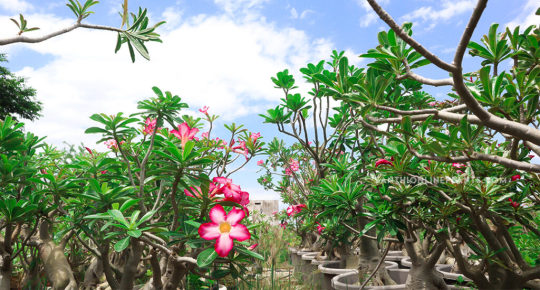
Flower
These adenium desert rose has attractive foliage, star shape, and their symmetrical pattern of petals that give a unique appearance. Adenium desert roses have a wide range of color shades that includes pink, white, red, and purple and some varieties have bi-color and multi-color too. The size of the flower varies from growing conditions generally adenium desert rose flowers scale 2 to 4 inches.

Soil
Soil should be on the PH scale of 6.5 to 7.0. These desert rose requires well-draining soil that helps to prevent waterlogging to avoid root spoiling. A normal mixture of Bio-NPK with sand goes well for the growth of adenium.

Watering
Adenium desert rose are succulents that don't require more water for their growth. While watering these require a less amount of water so to ensure after watering the top layer should be dry and water shouldn't stay in the pot. It’s better to water frequently in the growing season and reduce watering in the winter season.
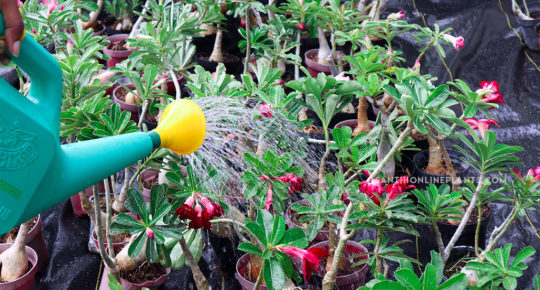
Sunlight
Desert rose plant requires bright light and indirect sunlight. Desert rose are grow both in outdoors and indoors. In outdoor conditions, they need to be placed in a shade receiving area to avoid high temperatures.

Fertilizers
Treat desert rose plant with Bio-NPK. Organic fertilizers such as seaweeds and composted materials are used in the growth of desert rose plants. The Desert rose plant is a slow-growing plant it only requires few nutrients. Application of steamed bone meal increase the colour of flower.

Propagation
Desert rose plants propagated through stem cuttings, seeds and grafting. For stem cuttings choose a healthy mother plant. The other technique is grafting in which join a piece of scion onto different rootstock.

Pruning
Pruning in this plants by cutting the infected branch helps to encourage new branching and by removing dead parts which helps in the efficient growth of this plant
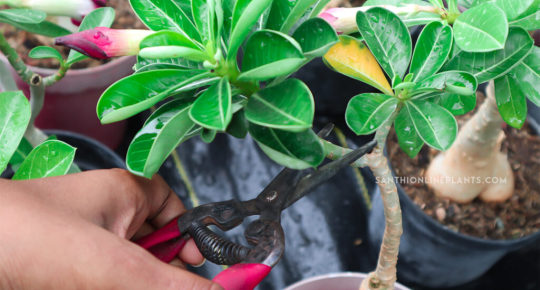
Repotting
Adenium plants are repotted after two years of planted. For repotting, the pot should be large and filled with well-draining soil.

#Image#Fertilizers#Treat desert rose plant with Bio-NPK. Organic fertilizers such as seaweeds and composted materials are used in the growth of desert rose pl#Propagation#Desert rose plants propagated through stem cuttings#seeds and grafting. For stem cuttings choose a healthy mother plant. The other technique is grafting in which join a piece of scion onto di#Pruning#Pruning in this plants by cutting the infected branch helps to encourage new branching and by removing dead parts which helps in the effici#Repotting#Adenium plants are repotted after two years of planted. For repotting#the pot should be large and filled with well-draining soil.
0 notes
Text
How Organic Fertilizers Work for Plants

When it comes to growing plants, there are a lot of different methods that you can use. One method is to grow plants in a soilless potting mix. Organic Plant Food Fertilizer is perfect for those who want to grow plants organically. The main benefit of using a soilless mix is that it eliminates the need for soil. This means that you won't have to worry about any harmful chemicals or pesticides getting into your plants. Another benefit of using a soilless mix is that it drains well and doesn't compact like soil does. This allows your roots to get the oxygen they need to thrive.
To make your own soilless potting mix, start with two parts peat moss to one part perlite. Add in some organic matter, such as composted leaves or manure, and mix well. You can also add a bit of lime to help balance the ph. The mixes are predominantly comprised of sphagnum peat moss. It is a growing medium for plants that omits actual dirt. In general, soilless potting mixes come with a moderate level. It is an exclusive organic blend for seed starting and plant propagation. Combined with perlite for use as an indoor planting mix.
0 notes
Text

growth | Buck/Tommy | 1236 words | rated T
tags: Tommy Kinard character study, gardening
A few weeks before Tommy picked up Howie's call and ended up flying four members of his former station into a hurricane – and incidentally inviting the beautiful hurricane that was Evan Buckley into his life – he'd planted an herb garden.
In retrospect, he wasn't even sure why he'd done it. He wasn't much of a gardener, and neither was he a particularly gifted home chef. His backyard looked nice, but it wasn't exactly artistic; there were no carefully-curated flower beds or beautiful raised plots overflowing with homegrown vegetables. Likewise, when he cooked at home, he stuck to the same handful of fairly utilitarian meals: spaghetti with turkey meatballs and sauce from a jar, or brown rice and baked salmon and green beans. Not that his food wouldn't have benefited from fresh herbs — it just didn't need it.
And yet, for some reason, he got off a shift and twenty minutes later found himself wandering the lumber aisles in the Lowe's near his house, 48 hours off ahead of him and a random home improvement magazine clutched in one hand.
Tommy's house was a little two bedroom bungalow, which the realtor had called "cozy" and Tommy would have described as "cramped" if he wasn't kind of a minimalist by nature (and more interested in the detached garage). The kitchen was small but functional, and located at the back of the house, which faced south. It had a big window over the sink, and a back door that opened out onto a small cedar deck that had been Tommy's first DIY project after he bought the place.
It wasn't the best deck in the world. It sloped a little to one side, and he'd applied the finish a little unevenly. But he was still proud of it.
He chose similar cedar boards for the herb garden. Built a counter kind of thing, a little taller than elbow height, with spaces where planters could nestle in and a shelf below for storage. He set it on the deck right below the kitchen window, thinking that once the plants got tall enough, he'd be able to see them through the window, maybe while he was doing dishes or something.
Maybe the green would be inspiring. Maybe he'd go out to the deck and trim a few sprigs of something to throw on his salmon. Add a little flavor to his life.
Tommy snorted to himself. Add a little flavor to his life. Who did he think he was? And yet...
He built the framework. Bought some terracotta planters. Went to a garden store the next day, carefully chose a big bag of potting soil and some seedlings and organic fertilizer and, a little self-consciously, a small blue enamelware watering can. He thought it might look nice on the storage shelf beneath the planters.
He started with just the basics, things that sounded familiar, like he might actually use them sometime: basil, mint, cilantro, oregano. Rosemary, because it reminded him of his mother.
Against all odds, the herb garden thrived. Tommy did discover the hard way that it really needed to be watered every day, when he came home from three OT shifts in a row to find his basil plants more than a little blasted by the LA sun. He rigged up a slightly janky DIY self-watering system with an old wine bottle, and that seemed to do the trick.
He still didn't really know what he was doing. Or why he was doing it. But he liked his herbs. It felt good to go out on the deck in the morning, and drink his coffee while he plucked the few weeds that appeared, and made sure the soil was properly moisturized.
Then Howie called.
Then Evan somersaulted into his life and looked at Tommy with stars in his eyes and sprained his best friend's ankle. Evan let Tommy kiss him in his kitchen, out of the blue, two fingers digging into the stubble on his chin. Evan asked him out for coffee and asked him for a second chance and asked him to a wedding.
Three weeks to the day after their disappointing first date, Evan came over to Tommy's house for the first time. The plan was that they would make dinner together and then walk down to the park in Tommy's neighborhood that was showing movies every Friday and Saturday, projecting them on a big inflatable screen.
He honestly wasn't sure whether they would make it to the movie this time, either – but now it was more because they seemed to have a hard time keeping their hands off one another whenever they were within arms' reach. He'd let the evening unspool in his head before Evan ever arrived: a nice dinner, and then dessert on the deck, and conversation, and then, when the mosquitos got too bad, a glass of wine in the living room, lights low, hands wandering. He didn’t really care about the movie.
They hadn't used the word "boyfriend," yet. But Tommy knew what it meant, if you asked a man to come over and cook you dinner at 7:00 PM in your own house.
So, Evan arrived, that first time. Tommy gave him the nickel tour, not that there was much to see – the living room, with its sparse bookshelf and much more robust DVD shelf; the office-slash-guest room; the master bedroom and the painfully obviously freshly-made bed; the garage and the car lift and Muay Thai mats. Evan was polite, complimentary, interested in the renovations Tommy had made during the five years he’d owned the place.
It wasn’t until they walked out on the deck that he’d shown real excitement.
“Look at this!” he cried, gravitating toward Tommy’s weird little herb garden like a puppy to a chew toy. “You didn’t tell me about this.”
“It’s – it’s nothing much,” Tommy said awkwardly. “Just something new I built a couple weeks ago. I don’t even know what to do with them, really.”
“You built this?” Evan said, enchanted, and Tommy watched him run his fingers along the sanded cedar frame, and bury his face in the fragrant plants, and rub one basil leaf gently between two fingertips and bring his fingers to his nose, breathing deep and turning to Tommy with a smile on his face. “This is incredible.”
“You think?” said Tommy, uncertain.
“Yeah, I think,” said Evan, beaming, and crossed the deck in two long strides and caught Tommy by the waist and kissed him, once, twice: brief, deep kisses that knocked Tommy’s whole world slightly off center. “Your oregano is gorgeous, it’s going to be absolutely perfect in the sauce.”
And then he whirled away, back inside, rattling around Tommy’s kitchen as if he belonged there, searching out pots and cutting boards and strainers. Tommy stood for a long moment in the middle of his own deck, slightly poleaxed, listening to Evan’s clatter with one ear and the burgeoning backyard crickets with the other, smelling the wafting scent of his herbs and the neighbors’ honeysuckle vines.
Oh, he thought. This is why I wanted an herb garden.
Because on some level, in some remote corner of his brain, he had known that Evan was waiting for him, a storm system just over the horizon. He’d needed to be ready for this. For making pasta sauce with fresh oregano, and kissing on the back deck, and growing something real.
read on AO3 >>>
44 notes
·
View notes
Text

Begonia 'Moonlight Butterfly'
A captivating display of dark, almost blackpink leaves adorned with intricate white veins, resembling the wings of a butterfly.
Plant care guide:
Light: Bright, indirect light. Avoid direct sunlight, which can scorch the leaves.
Water: Keep soil consistently moist but not soggy. Allow the top inch of soil to dry out slightly between waterings.
Soil: Well-draining potting mix rich in organic matter.
Temperature: 65-80°F (18-27°C). Avoid cold drafts and sudden temperature changes.
Humidity: Prefers moderate to high humidity. Misting the leaves regularly or using a humidifier can help maintain humidity.
Fertilizer: Apply a balanced liquid fertilizer diluted to half strength once a month during the growing season.
Garden decoration ideas:
These striking begonias are perfect for adding a touch of drama and elegance to your indoor garden. They can be displayed on their own or combined with other plants for a colorful and vibrant arrangement.
#houseplants #Plants #garden
37 notes
·
View notes
Text

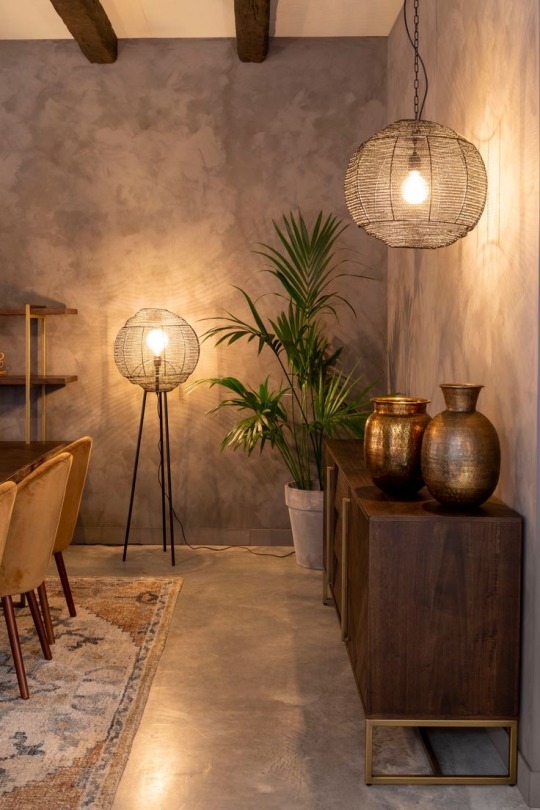
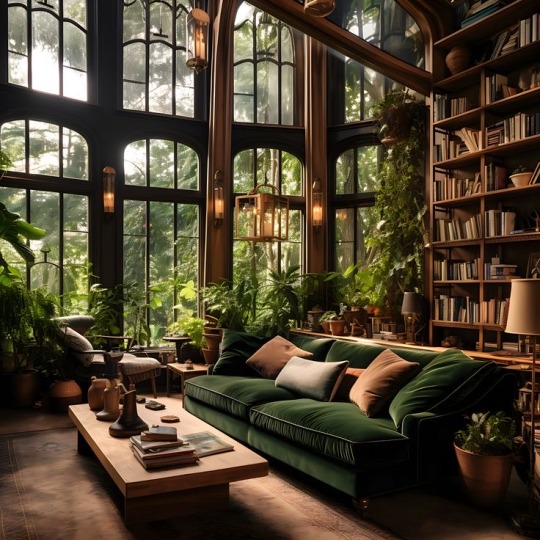
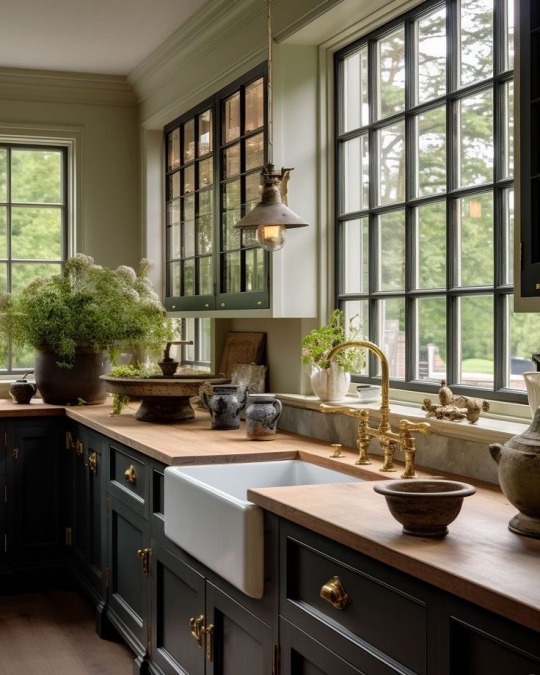
Ways to practice eco-friendly living in your home
1. Reduce energy consumption:
- Install energy-efficient appliances and LED light bulbs.
- Turn off lights and unplug electronics when not in use.
- Use natural light as much as possible.
- Set your thermostat to a lower temperature in winter and higher in summer.
- Insulate your home properly to reduce heating and cooling needs.
2. Save water:
- Fix any leaks in faucets and toilets promptly.
- Install low-flow showerheads and faucets.
- Collect rainwater for watering plants.
- Only run the dishwasher and washing machine with full loads.
- Use a broom instead of a hose to clean outdoor spaces.
3. Practice waste reduction:
- Recycle paper, plastic, glass, and metal.
- Compost kitchen scraps and yard waste.
- Opt for reusable products instead of disposable ones (e.g., cloth napkins, rechargeable batteries).
- Avoid single-use plastics, such as plastic bags and water bottles.
- Use a reusable shopping bag.
4. Use eco-friendly cleaning products:
- Choose natural, non-toxic cleaning products or make your own using ingredients like vinegar, baking soda, and lemon juice.
- Avoid products containing harmful chemicals that can harm the environment and your health.
5. Grow your own food:
- Plant a garden to grow vegetables, fruits, and herbs.
- Use organic and natural fertilizers instead of synthetic ones.
- Compost food scraps to enrich the soil.
6. Opt for sustainable materials:
- Choose furniture made from sustainable materials like bamboo or reclaimed wood.
- Use eco-friendly flooring options like bamboo, cork, or reclaimed hardwood.
- Select paint and other finishes that have low or no volatile organic compounds (VOCs).
7. Reduce plastic waste in the kitchen:
- Use glass or stainless-steel containers for food storage instead of plastic.
- Replace plastic wrap with beeswax wraps or reusable silicone covers.
- Use refillable water bottles and avoid buying bottled water.
8. Conserve energy in the kitchen:
- Use energy-efficient appliances.
- Cook with lids on pots and pans to retain heat and reduce cooking time.
- Opt for smaller appliances like toaster ovens instead of full-sized ovens when possible.
9. Encourage sustainable transportation:
- Use public transportation, walk, or bike whenever possible.
- Carpool or arrange a car-sharing service with neighbors or colleagues.
- Transition to an electric or hybrid vehicle if feasible.
10. Educate and involve your family:
- Teach your family about the importance of eco-friendly practices and involve them in the decision-making process.
- Encourage everyone to adopt sustainable habits and lead by example.
- Discuss environmental issues and brainstorm new ideas for greener living.
#home improvement#work from home#make money from home#homebrew#ecology#ecofriendly#sustainability#home design#home#acne treatment#homedesign#homemade#home decor#home business#home & lifestyle#homestuck#welcome home#homens de sunga#homeinterior#homestyle#cozyplaces#cozy glow#cozyhome#cozy cozy#cozy living#cozyvibes#cozy autumn#cozy fall#cozy mystery#cozycore
87 notes
·
View notes
Text




Calathea ornata
Information:
Common Name: Pinstripe plant, pinstripe calathea
Botanical Name: Goeppertia ornata (formerly Calathea ornata)
Family: Marantaceae
Calathea ornata, also known as the pinstripe plant, is a tropical houseplant and is considered one of the most elegant types of calatheas. It's known for its wide, pointed dark green leaves marked with sets of thin stripes in creamy white or pink. The pinstripe plant grows best in bright, indirect light, moist soil, temperatures between 65 to 85 degrees Fahrenheit, and high humidity.
Tips to Care and Maintain Calathea ornata:
Give this plant adequate bright light to thrive.
Water the plant regularly so the soil stays lightly moist but not soggy.
Use a peat-based potting soil
Fertilize monthly throughout the growing season.
Light: Give your Calathea ornata medium to bright indirect light. This plant is a great option for a north-, east-, or west-facing window; the harsh direct light of a south-facing window can be too strong.
Soil: Calathea ornata will grow best in a loose, well-draining potting mix that holds onto moisture. A peat-based mix is ideal—you can make your own by combining 2 parts peat moss, 2 parts orchid bark, 2 parts perlite, and 1 part organic compost. Some growers prefer to use a ready-made potting mix designed for African violets for their calatheas.
Water: Water your Calathea ornata consistently so that the soil stays moist but not soggy. Overwatering can cause root rot, which can kill the plant. Avoid letting the soil dry out beyond the top inch or so between waterings.
Temperature and Humidity: Keep this tropical plant in a place with moderate temperatures and lots of humidity. If your space is particularly dry, group your plant in with other plants in your collection to help create a more humid microclimate, or run a humidifier nearby to add moisture to the air.
Fertilizer: Feed your Calathea ornata with an organic liquid houseplant fertilizer diluted to half strength every two weeks during spring and summer. Stop fertilizing in the fall, when the plant goes dormant for the winter. Resume fertilizing the following spring.
Pruning: Use sharp, sterilized shears or scissors to cut away any brown or shriveled leaves at the base to keep your Calathea ornata looking healthy. You can also trim away any browned or dried-out leaf margins while leaving the rest of the leaf on the plant. Take care not to cut away more than about a third of your plant's leaves to avoid damaging its growth.
How to Treat Pests
Calathea ornata generally isn't prone to many issues but it can be affected by houseplant pests like spider mites, thrips, whiteflies, and scale. The best way to avoid pests is to prevent them with a few best practices: Examine plants carefully for signs of pests before buying, quarantine plants that show signs of an infestation, and keep an eye on your plants to spot pests and eliminate them early. Treat insect pests with organic pesticides like neem oil or remove them with horticultural soap. Cut away badly affected portions of the plant, bag them up, and put them in the trash outside to keep them from affecting your other plants.
Common Problems With Calathea Ornata
Calatheas aren't the easiest houseplants to please, but most issues can be remedied by adjusting the plant's environmental conditions or watering more consistently. Here are some common problems with Calathea ornata and their causes.
Curling Leaves: Curling leaves are your plant's way of telling you it needs a drink. If your plant's leaves are curling, give it a good soaking. Keep an eye on the soil moisture to avoid drying out.
Leaves Turning Brown: Browning leaves can indicate a few different issues, including cold drafts, dry air, or too much sun. Consider your plant's conditions and make adjustments.
Leaves Turning Yellow: Yellowing leaves can mean your plant is getting too much water. In severe cases, they can be a sign of root rot. Cut back on watering immediately. If that doesn't help, repot your plant in fresh soil and cut away any black, rotten roots in the process.
#plantblr#plantcore#plant blog#naturecore#nature#plant photography#plants#plantbased#calathea ornata#botany#studyblr#biology#leaves#stripes#writerscommunity#spilled ink#dark academia#light academia#writers on tumblr#information#informative#shitpost#green#home decor#organic#photographers on tumblr#beautiful photos#photoblog#photooftheday#photography
23 notes
·
View notes
Text
TRANSFORMERS x gn reader
『 hound ,, drift ,, rewind ,, first aid ,, gender neutral reader 』
-> household activities
— fluff ,, sfw ,, crack ,, comfort
— just some small household activities to do with the bots <3 these are headcannons ,, there’ll be scenarios in a separate post to these tho ! :3
- hound + folding clothes
| • hound has always found your clothing interesting ,, even if theres never really anything interesting about it
| • cybertronians dont have clothes to put on when they get cold ,, or to wear when they want to show off a new look ,, or for different sportive activities
| • it intrigued him ,, how you could easily change your outer look and find a new one
| • the most cybertronians had with that was mods and paint jobs ,, maybe a different limb if they got injured
| • he isnt too sure how to fold socks or shirts so you let him fold your pants whilst you do those
| • no matter how many times you show him how to fold socks hes still amazed and when he tries to do it he somehow fails
| • hound likes how they all look neat put up and folded ,, how it takes up little space no matter how many clothes you have
- first aid + cooking
| • he only asked you to show him how to cook because he sees you do it often
| • its a foreign thing to him ,, after all energon is liquid and if its not than its crystal like and inedible
| • not only that but first aid wants to do something nice for you which he cant due to him always being in the medbay ,, and even when hes off of work you're usually asleep
| • it gives him time alone with you that usually results in no interruptions ,, him growing closer to you ,, and a wonderful bonding and learning experience
| • on days you accidentally sleep in he usually makes you breakfast so you dont miss it or have to worry about being late
| • do compliment him :( he loves it and it makes him happy
- drift + dishes
| • he would find you doing your dishes one day ,, after you didnt text him after some time ,, so he would go find you in your room doing your dishes
| • he'd question you about them ,, since cybertronians only have cups and cubes to clean and even then it doesnt take too long
| • drift would offer to help ,, using his mass-displaced form and help with rinsing drying the dishes off so the job would get done faster
| • whilst in the midst of focus ,, you may get an idea and decide to splash a little water at him
| • little did you know that would start a little war between you two ,, with you both splashing water back forth at each other
| • its safe to say that the ground ,, counter ,, and both of you are soaked afterwards
- rewind + gardening
| • he offers to help you when he finds you taking care of some plants you've brought aboard the lost light ,, something about oxygen and carbon dioxide
| • he doesnt remember too much of what you said about it ,, just that you have them
| • rewind has a lot of knowledge in his database ,, though theres not a lot of organic things in there since he's dedicated his life to dominus ambus in a way
| • he'll be interested ,, standing over you as you pot the plant ,, switching the soil and putting a bit of fertilizer in the pot
| • rewind will ask questions about it ,, camera rolling to store away the information in his database
| • he'll learn about them ,, that they make oxygen from carbon dioxide ,, how its a cycle between you and the plant
| • since you breath in oxygen and breath out carbon dioxide ,, how the plant takes in carbon dioxide and releases oxygen ,, its somewhat interesting to him in a way
| • he'll definitely help if you let him ,, feeling how foreign the soil is under his digits is and how mushy it feels when watered
| • its quite the learning experience for him
#transformers x reader#x gender neutral reader#x reader#🌄.g1#hound x reader#transformers hound#hound#🌄.hound#🎇.mtmte#mtmte x reader#drift x reader#mtmte drift#mtmte first aid#first aid x reader#first aid#drift#rewind x reader#rewind#mtmte rewind#🎇.first aid#🎇.drift#🎇.rewind
133 notes
·
View notes
Text

III
“Agriculture itself must be overcome, as domestication, and because it removes more organic matter from the soil than it puts back. Permaculture is a technique that seems to attempt an agriculture that develops or reproduces itself and thus tends toward nature and away from domestication. It is one example of promising interim ways to survive while moving away from civilization. Cultivation within the cities is another aspect of practical transition, and a further step toward superseding domestication would be a more or less random propagation of plants, a la Johnny Appleseed.” — John Zerzan, On the Transition: Postscript to Future Primitive
So how can this be overcome? How can the shackles placed by technological slavery be broken? There are no ready made blueprints, programs or textbooks that have the one correct way or answers. If civilization is to be overcome it will be through individuals with all sorts of diverse ideas, experiments and actions.
For me, I see my path is by attempting to achieve more individual autonomy and self-reliance away from the dependency on techno-industrial society through permacultural subsistence gardening which can provide for me, my family, and other living creatures that inhabit the area I am in.
I first learned about permaculture from reading the zine Backwoods. Prior to this I was focused on the horticultural method of “productive gardening”. I suppose the difference between the two is permaculture and woodland gardening is ecologically designed to give back to the soil, and benefit other living organisms, animals, and the local ecosystem in general as much as to help oneself.
It is an ecological sustainable gardening practice of growing for yourself while simultaneously helping the environment around you. Each individual organism that takes part in the process whether insects, microbe, human and non human animals, all benefit from a mutual utilisation of working together and likewise so does the organic matter and minerals which are needed to create and sustain healthy soil, which in turn when all together creates healthy gardening successions, rich landscapes, biodiversity, and healthy ecosystems.
The individual designs her garden to suit the needs of the local environment or back yard. This includes finding out soil types, and studying how much sun hits the area, where and when different areas might be shaded. From this the individual will research what plants will suit the environmental conditions.
Perennial plants such as fruit trees and bushes combined with a mix of native annuals and self seeding annuals such as edible wild garlic, flowers like nasturtiums, soil enhancers like clover, medicinal herbs, all provide ground cover and help protect the soil from the weather, soil erosion, water retention, and provide fertilizer and mulch, which all help soil fertility, providing life to the organisms that live in and create soil. All combined help local wildlife, pollinators and other insects that are vital for a healthy garden as well as a healthy planet.
I have been gardening for the last four years and started focusing on the permaculture method last year. One does not need a lot of money to start growing. When I had a tiny backyard I used containers of old pots, buckets, and even bags. Seeds and plants can be bought cheap in the right places or else can be shoplifted easily enough. Last March I built raised beds from scaffolding planks I expropriated from a local building site which was closed due to the first lock down and started a mini forest garden on roughly a twenty foot by twenty foot strip of land. If one hasn’t a backyard guerrilla gardening is a viable option.
Seeds and cuttings can be got for free in your area if you know what you are looking for. I learned about native plants from plant folklore books which were rich in folklore and mythical stories based around each plant species, included in the stories was information on edible plants and when best to forage, which ones were poisonous, and the uses of others. Combined, the stories provided a great index for subsistence. The area I live in is urban but I could still find many plants growing in parks, gardens, and the side of roads.
I’m still a long way off achieving my full subsistence needs and gardening obviously won’t solve the majority of the problems that stem from civilization but I see it as a potential starting point in my own struggle for individual liberation and creating the life I want to live. I don’t think gardening is for everyone either, but for me I get great enjoyment and satisfaction watching plants grow and then eating the produce, and all without having to pay or work a boring ass job for. I just have to open my door and walk outside.
I’m no expert on gardening or permaculture so I will leave a list of books that have helped me and where I got inspiration from.
Renzo Connors the Anarcho-Gardener
#subsistence gardening#gardening#anarcho gardening#solarpunk#gardening as resistance#resistance#permaculture#small farms#small farm movement#community building#practical anarchy#practical anarchism#anarchist society#practical#revolution#anarchism#daily posts#communism#anti capitalist#anti capitalism#late stage capitalism#organization#grassroots#grass roots#anarchists#libraries#leftism#social issues#economy#economics
13 notes
·
View notes
Text

🍓🌱 Excited about growing your own organic strawberries right at home? 🌱🍓
Did you know you can grow delicious, pesticide-free strawberries even if you have limited space? 🍓🌿 Container gardening is the perfect solution! 🌞🏡
👩🌾👨🌾 Whether you're a seasoned gardener or just starting out, here are some tips for growing juicy strawberries in containers:
1️⃣ Choose a sunny spot: Strawberries love sunlight! Place your containers where they'll get at least 6-8 hours of direct sunlight daily.
2️⃣ Pick the right container: Opt for large containers with drainage holes to prevent waterlogging. Terra cotta or plastic pots work well.
3️⃣ Use quality soil: A well-draining, nutrient-rich soil mix (like compost and peat moss) is ideal for strawberries.
4️⃣ Planting time: Spring is perfect for planting strawberries. Space your plants about 8-12 inches apart to allow room for growth.
5️⃣ Watering and feeding: Keep the soil consistently moist, but not waterlogged. Feed your strawberries with organic fertilizer every 2-3 weeks.
6️⃣ Pest control: Keep an eye out for pests like slugs and birds. Netting can protect your berries while still allowing sunlight in.
➡️ Want to read my full article: How to Grow Organic Strawberries in Containers!
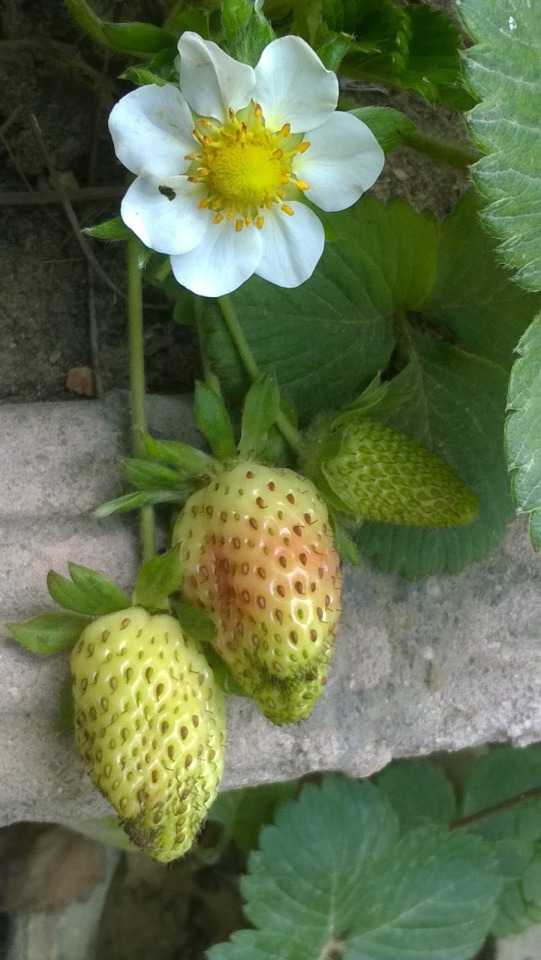
🎉 Growing your own strawberries is not only rewarding, but also a delicious way to enjoy fresh, organic fruit all summer long! Have you tried growing strawberries in containers? Share your tips and experiences below! 🍓💬
#gardening#garden#lovegardening#gardening tips#gyo#gardening uk#gardenchat#organic gardening#vegetable gardening#backyard#strawberry#strawberries#fruit#grower#growth#grow your own#grow your own food#gardens#gardenblr#gardencore#gardeners on tumblr#home and garden#my garden#potted garden#urban gardening#vegetable garden#plants#containergardening#container#container gardening
10 notes
·
View notes
Text
Celebrating Ostara: A Witch's Guide to the Spring Equinox.
🌸🌞🌿
As the wheel of the year turns to the spring equinox, we welcome Ostara, a time of balance, renewal, and the awakening of the Earth. Celebrated around March 20th, Ostara marks the moment when day and night are equal, heralding the arrival of longer days and the blossoming of spring. Let's explore the essence of Ostara, how witches celebrate this vibrant festival, and discover rituals, spells, and traditions to honor this season of growth and rebirth.
What is Ostara?
Ostara, named after the Germanic goddess Eostre, symbolizes fertility, new beginnings, and the balance between light and dark. It is a time to celebrate the Earth's renewal and the budding potential in every living thing.
How Do Witches Celebrate Ostara?
Witches celebrate Ostara by honoring the balance of light and dark, planting seeds, and engaging in rituals that emphasize growth, fertility, and new beginnings. It’s a time to connect with nature, embrace creativity, and set intentions for the coming months.
Rituals and Spells for Ostara:
🌱 Seed Planting Ritual: Plant seeds in your garden or in small pots indoors. As you plant, focus on the intentions you wish to grow and nurture throughout the year.
🌸 Flower Crown Creation: Make a flower crown using fresh blooms and greenery. Wear it during your rituals or celebrations to connect with the energy of spring.
🔥 Equinox Meditation: Meditate on the balance of light and dark within yourself and the world. Visualize harmonizing these energies, bringing balance and clarity to your life.
🕯️ Egg Magic: Decorate eggs with symbols of fertility and abundance. Use them in rituals or place them on your altar as a symbol of new beginnings.
🌿 Nature Walk and Foraging: Take a walk in nature to connect with the Earth’s awakening. Collect natural items like flowers, herbs, and stones to use in your rituals and spells.
Ostara and Sacred Symbols
🌸 Flowers and Eggs: Symbols of fertility, rebirth, and new life. Use them to decorate your altar and home, and incorporate them into your rituals.
🌞 The Sun: Representing the growing strength of the light and the return of warmth. Honor the sun with sun symbols, yellow and gold candles, and sun-inspired art.
🌱 Seeds and Sprouts: Emblems of potential and new growth. Plant them with intention and watch them flourish as the season progresses.
Other Ostara Traditions
🥚 Egg Hunts: Organize an egg hunt for children or adults. Hide decorated eggs, symbolizing the search for new opportunities and the joy of discovery.
🧹 Spring Cleaning: Clean and cleanse your home to clear away winter's stagnation. Use this time to refresh your living space and invite in the energy of renewal.
🍽️ Feasting: Share a meal with seasonal foods like fresh greens, eggs, sprouts, and seeds. Celebrate the abundance and nourishment of the Earth.
🎨 Creative Expression: Embrace the creative energy of spring by engaging in artistic activities like painting, crafting, or writing.
Ostara is a time to honor the balance of nature, celebrate the Earth's renewal, and embrace the potential within ourselves. Whether through rituals, spells, or simply enjoying the beauty of spring, Ostara offers a moment to connect deeply with the cycles of life and the promise of new beginnings. As we celebrate Ostara, may the light and warmth of the season fill your heart with joy, may your intentions take root and flourish, and may the magic of spring inspire your spirit.
🌸🌞🌿
#baby witch#beginner witch#book of shadows#closet witch#grimoire#ostara#wheel of the year#witchcraft 101#green witch#sea witch#witchcraft#eclectic witch#witch community#witch resources#witch tips#witchblr#witchcraft community#witches of tumblr#witchythings
19 notes
·
View notes
Text
More than Seaweeds
Mermaid's Herbal Compendium

Navigation: Masterlist✦Ask Rules✦Feedback Tips
Askbox✦Sources✦Paid Readings

Name: Basil
Scientific name: Ocimum selloi Benth.
Disclaimer: As English is not my native language, there may be some errors in scientific expressions. I am also using local resources.
TECHNICAL USAGE
History:
Due to the shape of its leaves (heart), it was considered a symbol of love in Italy and of mourning in Greece. (Portal São Francisco, 2016)
4,000 years ago, the Hindus, who were percussionists in the culture of basil, exported it to Egypt. (Portal São Francisco, 2016)
In the last century, basil was used by shoemakers to attenuate the smell of leather. (Portal São Francisco, 2016)
The name "basilicum" has its origin in the Greek "basilikós," which means "of the kings or royal," to indicate its nobility. The Greek botanist Theophrastus, in the 3rd century BC, defined basil as an herb of kings. (History of Ingredients, 2016)
Description:
Plant characteristics: Basil is an herbaceous plant grown in gardens and widely known throughout Brazil. It is characterized by the pleasant smell that is released from its leaves. It has a quadrangular stem, and the leaves are opposite, sharp, and abundant. The plant produces small white flowers arranged on an elongated axis, with secondary inflorescences formed on each axis. The corolla has four pieces, and the plant bears fruit with four dark nuclei. It is a meliferous plant. Basil can be propagated by seeds or cuttings taken from the branches. It thrives in fertile soils rich in organic matter, permeable, and with high temperatures. (Treatise on Medicinal Plants, 2014)
Propagation: Basil can be propagated by seeds or cuttings from branches. Basil seeds are sown in 200-cell expanded polystyrene trays containing commercial substrate and kept in protected cultivation. At 30 days after sowing, the seedlings have four definitive leaves and are suitable for transplanting. (PEREIRA; MOREIRA, 2011)
Cultivation: Seedlings can be planted in pots or nurseries throughout the year. For this, the beds must be well prepared, raised to a height of 15 cm. Use 150 g of well-tanned bovine manure per square meter of bed and mix well. Sow the seeds and cover with 0.5 cm of light soil or fine sawdust. The recommended spacing is 30 cm between lines and 30 cm between plants. Irrigate at least once a day, preferably in the early morning or late afternoon. After 60 days of planting in the beds, the first harvest can be made by cutting the plant at 20 cm from the soil. (PEREIRA; MOREIRA, 2011)
How to choose and where to find:
Fresh: Fresh bunches and pots of basil can be found in fairs, markets, and supermarkets. Choose branches with lush leaves that are not stained or wilted.
Dry: Dry basil can be found in supermarkets and specialty stores. Look for products in dark packaging, protected from light, to prevent loss of aroma. Check the expiration date.
How to Store:
Fresh:
Basil spoils quickly, but it can be packed in plastic packaging and dried for up to three days at most.
Chop the leaves and place them in a closed glass container with oil.
Dry: Store in a sealed container, away from light and humidity.
How to dry:
Buy two large bundles of basil, wash them well, and spread them on a clean cloth until dry.
Separate the leaves and make layers of leaves in a glass bowl, alternating with thin layers of coarse salt.
Cover the glass bowl with plastic wrap and leave it at room temperature.
Stir once a day for the first three days.
The dried basil can be used for up to two months. The leaves become dry, and the salt absorbs the aroma of basil. You can use only the leaves or also the coarse salt.
Chemical Composition:
Tannins: Tannins are astringent and hemostatic, and their therapeutic applications are related to these properties. They are mainly used in the tanning and paint industries. They are also used in laboratories to detect proteins and alkaloids and as antidotes in cases of poisoning by alkaloid plants.
Flavonoids: The therapeutic functions of flavonoids are not yet fully understood. The group is known for its anti-inflammatory, anti-allergic, and vasoprotective effects (treatment of thrombosis). Rutin and hesperidin are important flavonoids used in the treatment of capillary fragility.
Saponins: Saponoside glycosides are named for their ability to form abundant foam when agitated with water (from Latin "frog" = soap). They taste bitter and acrid, and drugs containing them are usually sternutatory (cause sneezing) and irritating to the mucous membranes. They are non-nitrogen compounds that dissolve in water, producing foaming solutions by decreasing the surface tension of the liquid. They also have the properties of emulsifying oils and causing hemolysis. The latter is due to the ability of the glycoside to combine with the cholesterol molecules present in the erythrocyte membrane, disrupting the internal-external balance and promoting the rupture of the cell, resulting in the release of hemoglobin.
Essential Oils:
o Thymol: It has carminative, anti-spasmodic, expectorant, and anti-inflammatory properties. It also has significant antiseptic potential.
o Methyl-chavicol: It has antimicrobial, anti-inflammatory, local anesthetic, and insecticidal activities.
o Linalool: It is used for its woody, floral, and refreshing aroma.
o Eugenol: It has anesthetic, bactericidal, antifungal, and flavoring properties, with a hot and spicy note.
o Cineol: It has decongestant and anti-inflammatory properties and gives a eucalyptus aroma.
o Pyrene
Herbal Actions:
Digestant: An herb that promotes good digestion.
Carminative: Herbs or essential oils that help the intestines release gas by relaxing gut spasms and increasing peristalsis to expel gas.
Sweetener: It has the ability to sweeten.
Aperientes: Aperientes herbs are mild laxatives.
Indications: Basil is beneficial for those who have difficulties in digestion, gas, heartburn, and headaches resulting from heavy or inadequate food. It facilitates the functioning of the intestines and acts as a diuretic. It is good for coughs, vomiting, and bad breath. Along with malva and sage, it helps in mouth infections.
Dosage: There is little information on the safe and effective dosage of basil. Usually, 10 to 20 ml of fresh basil leaf juice is used once a day, or teas can be made by infusing 2 grams of fresh basil or dried herb in boiling water twice a day.
Contraindications: Basil is not suitable for long-term use in children, and it should not be used by pregnant women in the first three months of pregnancy.
MAGICAL USAGE
Gender: Masculine
Planet: Mars
Element: Fire
Deities: Ares, Eros, Zeus, Apollo, Vishnu, and Krishna
Tarot Cards: The Empress, Justice, Six of Swords, Ten of Cups
Zodiac: Virgo, Scorpio, Sagittarius
Sabbath: Yule, Imbolc
Magical Uses (under observation of effectiveness): Basil is linked to love, health, exorcism, and clairvoyance in magical practices. Its fresh leaves can be used as a natural scent to attract passion. Hanging some branches around the house can protect the environment and bring permanent joy. In some ancient cultures, basil was placed on the chest of the dead as a symbol of a passport to paradise. Fun fact: There are over 64 types of basil. (GORI, 2021)
Therapeutic and Enchanted Recipes:
PROSPERITY TEA:
INGREDIENTS: 1 teaspoon of basil, 1 teaspoon of thyme.
PREPARATION: Heat the water for 10 minutes, then turn off the heat. Add the basil and thyme and let it steep for 15 minutes.
CLAIRVOYANCE TEA:
INGREDIENTS: 1 teaspoon of basil, 1 teaspoon of hibiscus.
PREPARATION: Heat the water for 10 minutes, then turn off the heat. Add the basil and hibiscus and let it steep for 15 minutes. Drink four sips before your divination practices, especially oracles.
MIX OF HERBS FOR LOVE:
INGREDIENTS: 1 cup of basil, 1 cup of rose petals and buds, 1/2 cup of patchouli leaves, 1/2 cup of lavender flowers, 2 tablespoons of dragon's blood.
PREPARATION: Place this herbal mixture in a bowl in your home to attract love.
HAPPY SIPS:
*This is a recipe that makes me feel really happy...
INGREDIENTS: Fresh basil leaves, fresh strawberries.
PREPARATION: Make a flavored water by adding as much basil and strawberry as your heart desires. Let it sit for a while (to taste) and drink it. I used to make this a lot when working at the office, and it made me feel fresh and happy.
Sources:
CUNNINGHAM, Scott. Enciclopédia das Ervas Mágicas do Cunningham. 1ª ed. São Paulo: Editora Alfabeto, 2021.
PRIETO, Claudiney. Rituais de Magia com o Tarô. 1ª ed. São Paulo: Editora Alfabeto, 2021.
GORI, Tânia. Herbologia Mágica. 2ª ed. São Paulo: Editora Alfabeto, 2021.
CABOT, Laurie; CABOT, Penny; PENCZAK, Cristopher. Tradução de Virginia Dalbo. Livro de Feitiços de Laurie Cabot. 3ª ed. São Paulo. Editora Alfabeto, 2021.
LADDY, Brianna. Apostila Magia das Ervas. 2019. Her Instagram
LADDY, Brianna. 25 Feitiços usando a Magia das Ervas. 2021. Her Instagram
MINHAVIDA. Manjericão alivia problemas intestinais e tem ação anti-inflamatória. Disponível em: https://www.minhavida.com.br/materias/materia-11744#:~:text=Existe%20pouca%20informa%C3%A7%C3%A3o%20sobre%20a,fervente%20duas%20vezes%20ao%20dia. Acesso em: 11 abr. 2021.
SOCIEDADE BRASILEIRA DE FARMACOGNOSIA. Taninos. Disponível em: http://www.sbfgnosia.org.br/Ensino/taninos.html. Acesso em: 11 abr. 2021.
PARODI, Lorenzo. MANJERICÃO. Disponível em: http://www.ingredientes.blog.br/. Acesso em: 11 abr. 2021.
PORTAL SÃO FRANCISCO. Manjericão. Disponível em: https://www.portalsaofrancisco.com.br/alimentos/manjericao#:~:text=Devido%20%C3%A0%20forma%20de%20suas%20folhas%2C%20(cora%C3%A7%C3%A3o)%2C%20era,atenuar%20o%20cheiro%20do%20couro. Acesso em: 11 abr. 2021.
GRANDI, Telma Sueli Mesquita. Tratado das plantas medicinais [recurso eletrônico]: mineiras, nativas e cultivadas. 1. ed. – Dados eletrônicos. Belo Horizonte: Adaequatio Estúdio, 2014. (Download the book HERE)
HOFFMANN, David. Tradução Euclides Luiz Calloni. O guia completo das plantas medicinais: ervas de A a Z para tratar doenças; restabelecer a saúde e o bem-estar. 1ª ed. São Paulo: Cultrix, 2017.
(CC) AstroJulia Some Rights Reserved
#astrojulia#astrology#witchblr#astroblr#all about astrology#astro community#astro observations#astrology notes#witch community#herbology#all about witchcraft#herbs#basil#spells
81 notes
·
View notes
Text
A basic starter project if you want to start growing your own food but have no money & no experience, assuming you like green onions.
Supplies needed: Dead potted plant from free pile/dumpster/friend or family member, used food container, green onion ends.

Steps:
1. Remove lid from container, it's now your plant pot's saucer

2. Either poke holes very carefully and slowly (not ideal) or slice the corners off with scissors (better)

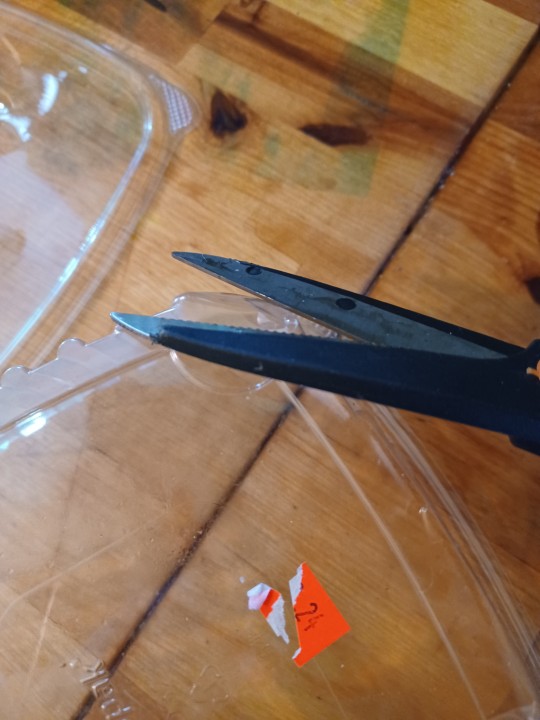
3. Remove soil from the dead plant's pot, put in container. This one was super heavy in perlite (the white stuff, helps with drainage), so I mixed in another pot that had more organic matter (brown stuff, mostly helps retain moisture, sometimes provides nutrients). Water until water comes out the bottom, then let drain in sink until until it's done. Put pot on lid:

4. Stick the green onions in, deep enough that they can stand up on their own, or until the white part is covered:
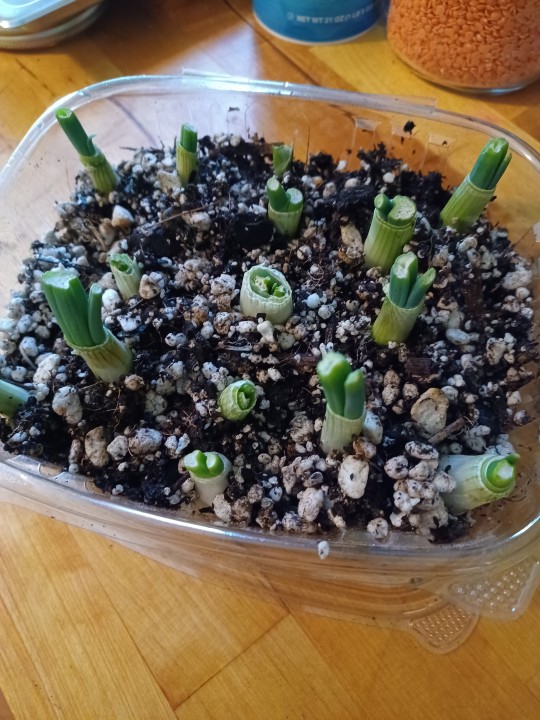
5. Stick in window, water when dry, and wait:
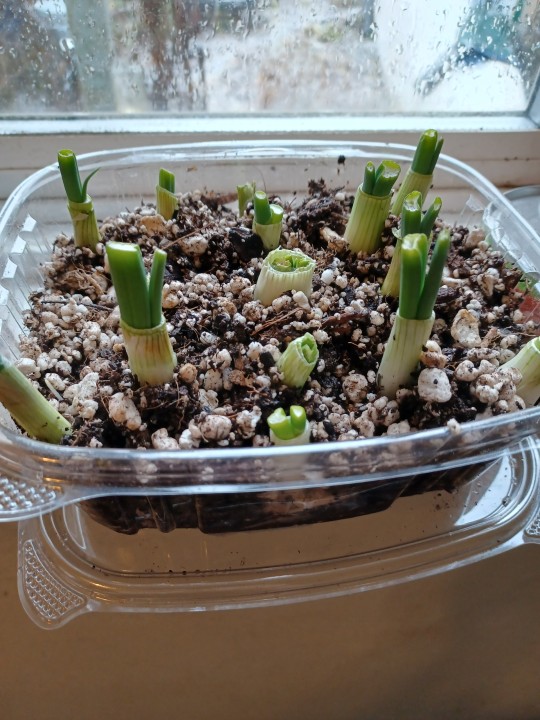
Why not just stick them in water?
Because they make the water really smelly.
Just change the water often, then it won't stink.
I will forget, and then it will stink. Plus, I prefer growing in soil.
Why do you prefer soil?
Thanks for asking! I started because growing them in water didn't work well for me. But on top of that, if you regrow in water, eventually their growth will peter out. This is because in addition to water and carbon dioxide, plants need other nutrients. These are stored in the bulbs of green onions, but they will be depleted by growth if the plant can't replace them. Potting soil often has leftover nutrients, and if you've got compost you can also mix that in.
Why not just put fertilizer in the water?
Two reasons. First off, that's a great way to grow algea, unless you make sure the water isn't getting light. Secondly, most cheap, widely available fertilizers are meant to be used for plants that are in soil, so they're not complete (they're missing iron and maybe some other things? It's been a while since i looked it up). So eventually, if you use water and normal ferts, the plant will stop growing. If you have access to hydroponic ferts, those would work, but you also have enough money that you're not the target audience for this post.
I don't trust the potting soil from random plants.
Completely understandable, and probably smart too. In that case, you have a couple other options if you want soil for free. First off, you could look for dead vegetable or other edible plants in pots, and know that those will not have been treated with something that makes them inedible to humans. You can also look for free bags of partially used potting soil in your local buy-nothing/free stuff groups/craigslist/nextdoor/mutual aid groups.
What if I have some money for soil?
Then you can look for potting soil, or make your own (plenty of recipes online for this)
Help! There are tiny flies that look like fruit flies!
Those are probably fungus gnats, and there's plenty of ways to get rid of them. My two favorites are watering a bit less and adding half an inch of sand to the top, making your plants an unsuitable habitat, or getting a mosquito dunk and keeping it in your watering can. Mosquito dunks have Bt, a type of bacteria that kills mosquitos, fungus gnats, and other related insects. There are other types of Bt that go after other types of insect, such as cabbage moths. It's considered an organic treatment.
What about other pests?
I've literally never seen them get other pests indoors.
How much light do they need?
As much as you can give them, probably. If you have a window that gets midday sun, use that. Or a grow light. If they don't get enough light, they'll be floppy and pale, still edible, but not as flavorful.
When can I harvest?
When it wouldn't look silly to harvest them. I generally wait until they're at least a foot tall (30cm). I'll post an update when I do.
Why didn't you just use the dead plant's pot, dumbass?
A) it didn't have a saucer to protect the surface underneath, B) this is a concept post, and often plant pots are too wide to fit in window sills, and C) I didn't like the pot.
Won't it just grow into a bulb?
Nope, green onions are actually usually a different type than bulbing onions. Usually. And they're perennial! I've never had one try forming a bulb, but you can just eat them if yours do.
Can I ask you another question?
Yep! I'll add it to the update.
194 notes
·
View notes
Note
Hey do you happen to know of any resources for someone in Iowa looking to get into native plant gardening? Thanks in advance! (Love your blog btw)
*cracks knuckles* sorry for keeping you hanging since November 3rd, homie, but I'm back home and down to get started!
Before I do, a special reminder that I'm not based in Iowa! I don't think I've ever even set foot in Iowa. I'm a Florida girlie lol. However, I will do my best to give you my advice and find some resources for you!
In my experience, many native plants grow slowly from seed. This could be because I mostly prefer perennials (I am way too lazy to replace an annual every year), but they can take awhile to germinate and an even longer while to size up. I've gotten seeds that say to wait upwards of 3 weeks to see any germination, and that's often after waiting a month or more for proper cold stratification! All of this is just to say--you gotta have a bit of patience when it comes to all gardening, but especially with native plants!
If you can get your hands on some seeds now, they'll likely need cold stratification. Fortunately, cold stratification is happening right now--put the seeds where you want them to grow, and let chilly winters do the work for you! Needing cold stratification basically means the plant has evolved to know it needs to wait until after winter to start germinating, so as things warm back up in spring, your seeds'll start growing!
Once they start growing and get established, they'll really start going--if they're in their perfect conditions, they'll be more than ready to take over a bit and manage on their own! Keep an eye out for watering needs, but generally I find native plants don't need much when it comes to fertilizer and pesticides. If you don't want things to spread a lot, you can always choose to grow certain plants in pots instead--or if you're really determined to grow a plant your soil isn't quite right for, a pot does wonders. My soil isn't very moist, so I grow a good chunk of my swamp milkweeds in pots to keep a better eye on their care.

Iowa's got a handful of growing zones going on, so knowing what the zone for your region is will help you pick the best plants! You can also pick plants known to have grown historically well in your region--I've seen plant range maps break things down by counties for my state, which helps give a good idea of whether it's a good idea for me to grow something touted as a native to my state. It's entirely possible for something to be native to your state, but not your half of the state, for example!
Browsing through a couple of sites, I hope these'll be helpful to you!
This is a link to Iowa Native Plants, which has a nice primer on the importance of native gardening as well as a few guides to native plants in their Finder tab! They also seem to sell a hanfdul of books on native gardening that may be an interesting read for you!
My Home Park appears to have a lot of information on native plants, and sells native plants that can be shipped to your state! I can't say I've ever had a plant shipped to me before, let alone from them (they don't service my state) but it could be worth a shot! If anything else, could be a good source of information! They also have a blog, and a feature that lets you mock up a garden to see what it'd look like (I didn't try it though). They also seem to service North Dakota, South Dakota, Nebraska, Kansas, Minnesota, Missouri, Wisconsin, Michigan, Illinois, Indiana, Kentucky, Tennessee, Ohio, West Virginia, Virginia, Pennsylvania, Maryland, Delaware, New Jersey, New York, Connecticut, Massachusetts, Vermont, New Hampshire, Rhode Island, and Maine.
The Tallgrass Prairie Center links to a ton of resources on learning about native plants, planting them, landowner incentive programs, and organizations you can join that are full of others who are passionate about native plants! The Tallgrass Prairie Center itself aims to establish and protect native plants, restore ecosystems, and increase awareness and appreciation of the Tallgrass Prairie Ecosystem. I think their site's definitely worth a look-through, or you can use it as a bouncing off point to find other sites full of info!
The Iowa Native Plant Society is a nonprofit organization full of people who are enthusiastic about native plants! They host field trips, workshops, have a newsletter, and more! It could be a fun way to learn more about native ecosystems on their trips, and if they're anything like the native plant society for my state, the calendar on their site will probably start lighting up with different chapters' native plant sales as we get closer to spring, so keep an eye out! They've also got books and lots of resource links on their site!
Oftentimes when I look up information on how to grow a particular plant in my state, the university extensions office is one of the best resources. As such, I think the Iowa State University's Extension and Outreach website is likely to have some good info for you about gardening! I've also in the past emailed some staff from various offices questions about native gardening and gotten good answers, so they're definitely a resource to be utilized!
I almost forgot to link the Xerces Society! The Xerces Society for Invertebrate Conservation has a primary focus of protecting insects in the US, but that often goes hand in hand with native plants, so they're a great resource for learning about plants and the insects that rely on them! Especially helpful is their Pollinator Conservation Resource Center, which has lists of plants and suppliers by region! You can also find just their plant lists here!
Speaking of plant lists, The National Wildlife Federation has a list of keystone plants by ecoregion! Keystone plants are highly important, as they're vital to the lifecycle of many species of insect, which then help feed birds and other creatures--you get the picture. I used the National Wildife Federation a good bit when I was writing my Biodiversity Saga on increasing biodiversity in your yard/on your balcony/in your area on a budget.
iNaturalist is a fantastic website for cataloguing the cool insects you find in your new native garden, as well as learning about the variety of plants, animals, insects, etc. that are in your area! Make an account and just vibe around!
Books can be a great resource! Unfortunately, my attention span is frequently lacking when it comes to books, and I definitely haven't read any that focus on Iowa's native flora. However! I've got a few general books that are nice reads, so you can definitely see if you can find these in a library or online (I'm including Thriftbooks links because fuck Amazon).
Hellstrip Gardening by Evelyn J. Hadden is a book I read last month that honestly inspired so many new projects out of me that next year is gonna be busy. Might as well get a healthy dose of inspiration now so you can do some planning and be roaring and ready to go come spring! I liveblogged it on my gardening blog, and shared some of my favorite notes as well!
Attracting Native Pollinators by the Xerces Society is a book that offers a generalized view on why its important, ways you can utilize native plants at any scale from swaths of farmland to a school garden or a small yard, and provides lists of plants that can be good for your region near the end! They also have Gardening for Butterflies, which I honestly haven't read yet, but I checked it out from the library so Mayhaps Soon. PS: you can buy Attracting Native Pollinators and Gardening for Butterflies from the Xerces site directly, and support their work! However. Hoo buddy, the pricing.
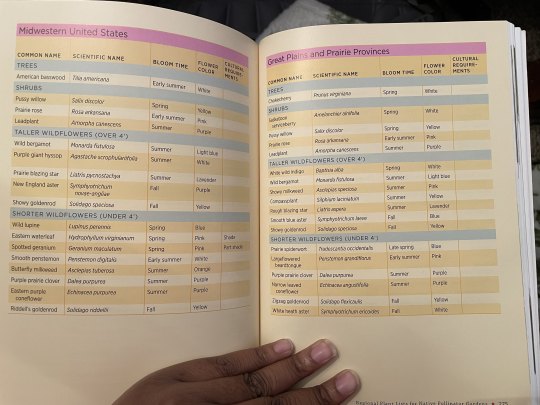
(Psst, here's the plant list from Attracting Native Pollinators, don't tell Xerces)
My final message to you, young padawan, is to grow milkweed. If there's a milkweed native to your state, grow it. If there's several native to your region, grow a ton of it. Milkweed is the host plant for Monarchs, but it's also such a high-value nectar source for so many other insects you've just gotta try and grow some in my book. Also a lot of the sites I saw for your state had pictures of blazing star and black eyed susans and let me tell you. Plant those. You'll have so many happy pollinators.
I can't think of anything else. If any Iowa gardeners wanna chime in with their favorite resources and such, feel free to!
#gardening#iowa#native plants#native gardening#outdoor gardening#resources#out of queue#ani rambles#answered asks#anonymous#ok time to eat something today peace out byeeeee
31 notes
·
View notes